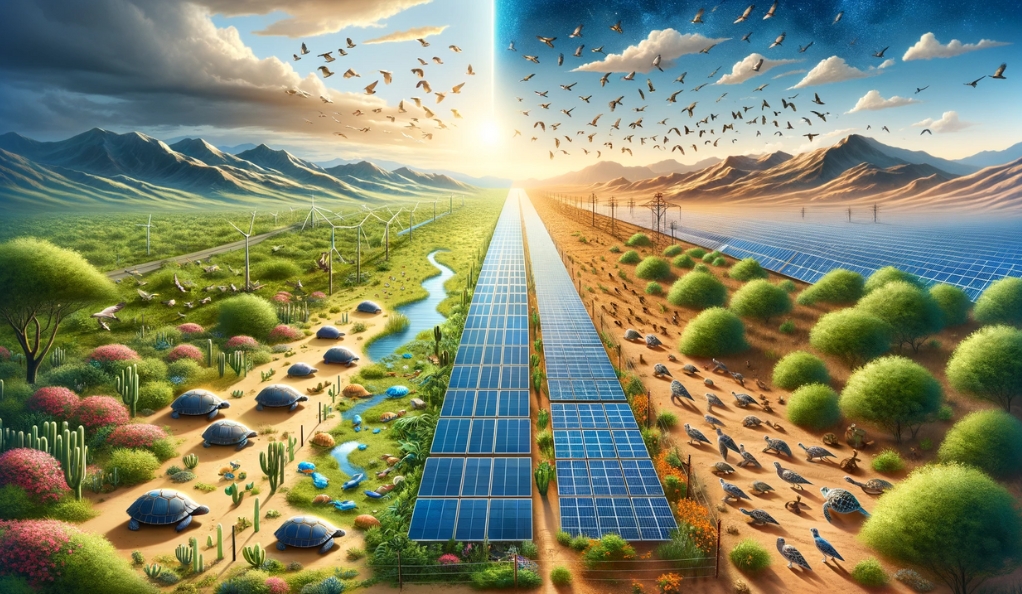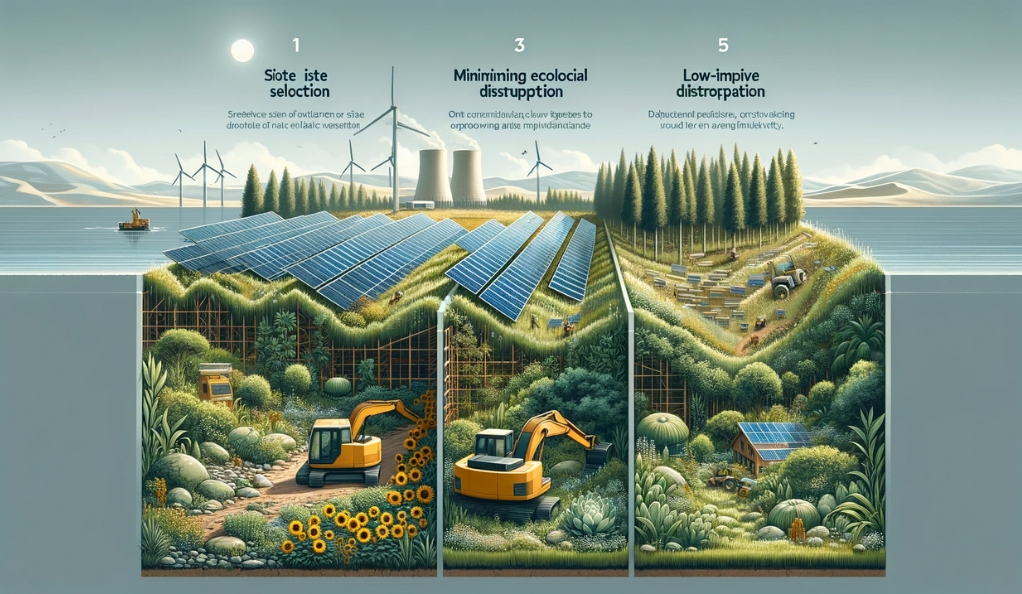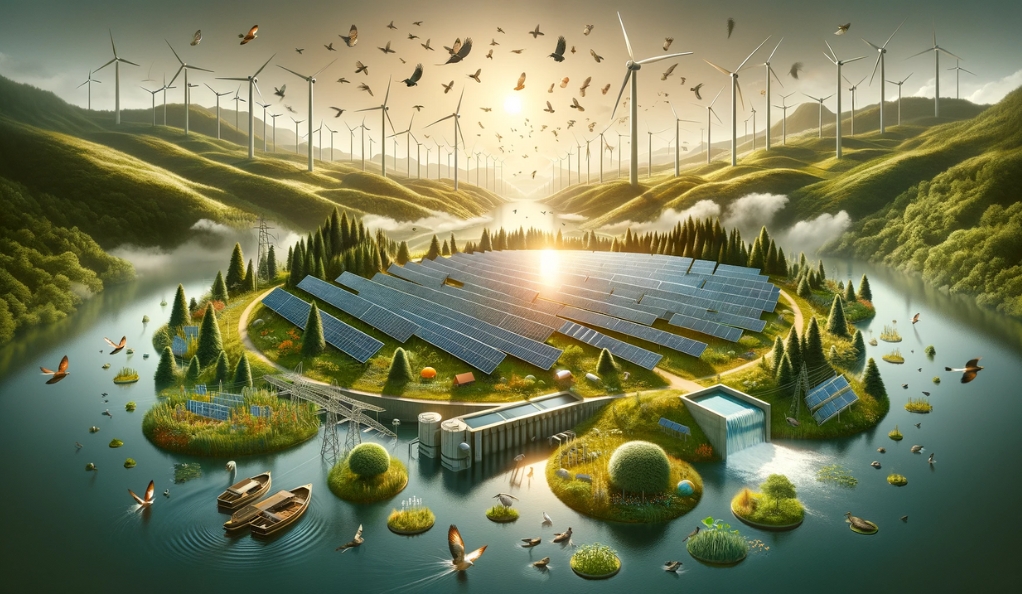Solar energy, hailed as a clean and renewable source, has seen a rapid expansion in recent years. Solar farms, large-scale installations of solar panels, are pivotal in harnessing the sun’s energy. However, as we embrace this green technology, it’s crucial to understand its ecological footprint and strive for a balance between energy production and environmental preservation.
The Rise of Solar Energy
Solar farms have become increasingly popular due to their ability to generate significant amounts of electricity without emitting greenhouse gases during operation. Unlike fossil fuels, solar energy is abundant and accessible, making it a key player in the global shift towards sustainable energy.
Understanding Solar Farms
A solar farm, or solar park, is a large area where photovoltaic (PV) panels are installed to capture sunlight and convert it into electricity. These installations vary in size, ranging from small, community-serving arrays to massive parks spanning hundreds of acres. They are typically found in areas with high solar irradiance, such as deserts or open fields.
Ecological Footprint of Solar Farms
While solar farms are environmentally friendly in terms of reducing carbon emissions, their ecological footprint is a growing concern. The construction and operation of solar farms can lead to land use changes, habitat disruption, and potential impacts on local wildlife and ecosystems. For instance, clearing land for a solar farm may disrupt the natural habitat of native species, leading to issues like habitat fragmentation or alteration of local biodiversity.
| Aspect | Impact on Environment |
|---|---|
| Land Use | Potential habitat loss and land degradation. |
| Water Usage | Minimal water use compared to conventional energy sources, but cleaning of panels requires water. |
| Emission Reduction | Significant reduction in greenhouse gas emissions during operation. |
| Wildlife Interaction | Possible disruption of local fauna, requiring careful planning and mitigation strategies. |
Balancing Act: Energy and Ecology
The key challenge lies in balancing the need for clean energy with ecological considerations. This involves careful site selection, integrating environmental impact assessments into planning, and exploring innovative designs that minimize disruption to local ecosystems. By addressing these concerns, solar farms can be developed in a way that harmonizes our energy needs with the imperative to preserve biodiversity.
The Interplay Between Solar Farms and Local Biodiversity

The expansion of solar farms brings with it a complex relationship with the local ecosystems. Understanding this interplay is crucial for developing strategies that protect and even enhance biodiversity around solar installations.
Impact on Flora and Fauna
Solar farms can have varied effects on local wildlife and plant life. The alteration of land for solar panel installation can disrupt existing habitats, but it can also create new microhabitats. For instance, the shade provided by solar panels can lead to cooler ground temperatures, which might benefit certain plant species.
Biodiversity Changes Near Solar Installations
Several studies have highlighted both positive and negative impacts of solar farms on biodiversity:
- Positive Impact: In some regions, solar farms have been found to act as safe havens for wildlife, providing shelter and a reduced threat from agricultural activities.
- Negative Impact: Conversely, in other areas, the construction of solar farms has led to habitat loss, especially for ground-nesting birds and certain mammal species.
Examples of Biodiversity Impact by Solar Farms:
- California, USA
- Impact on Biodiversity: Positive
- Details: Increased population of desert tortoises due to reduced land disturbances.
- United Kingdom
- Impact on Biodiversity: Mixed
- Details: Beneficial for some bird species but detrimental to ground-nesting birds.
- Rajasthan, India
- Impact on Biodiversity: Negative
- Details: Disruption of migratory paths for certain wildlife species.
Mitigating Negative Impacts
To mitigate these impacts, several measures can be taken:
- Habitat Creation: Designing solar farms to include natural habitats can help preserve local flora and fauna.
- Eco-Friendly Practices: Implementing eco-friendly construction and maintenance practices to minimize disturbance.
- Continuous Monitoring: Regular monitoring of biodiversity to understand long-term impacts and adapt strategies accordingly.
Solar Farms as Potential Biodiversity Hotspots
Interestingly, with thoughtful design and management, solar farms have the potential to become biodiversity hotspots. By creating a mosaic of habitats, such as grasslands, wetlands, or shrublands within and around solar installations, these areas can support a wide range of species.
The relationship between solar farms and biodiversity is not straightforward. While there are challenges, there are also opportunities to enhance local ecosystems. The key lies in informed planning and ongoing ecological management to ensure that solar farms contribute positively to the local biodiversity.
Innovative Designs for Eco-Friendly Solar Farms
As the demand for renewable energy grows, so does the need for solar farms that harmonize with the natural environment. Innovative design strategies are key to creating solar installations that not only generate clean energy but also support and enhance local ecosystems.
Integrating Solar Panels with Natural Habitats
The design of solar farms can significantly influence their ecological impact. By integrating solar panels into natural landscapes, we can minimize habitat disruption and even create new ecological opportunities.
- Elevated Panels: Raising solar panels allows for vegetation growth and wildlife movement underneath.
- Agrivoltaics: This approach combines agriculture with solar energy production, allowing for dual land use.
- Floating Solar Farms: Installed on bodies of water, these solar farms can reduce water evaporation and algae growth while generating energy.
Examples of Biodiversity-Friendly Solar Farm Designs
Innovative solar farm designs around the world are setting examples for how renewable energy and ecology can coexist:
- Germany’s Bio-Solar Farms: These farms incorporate biodiversity concepts, with areas set aside for native flora and fauna.
- Japan’s Solar Islands: Floating solar installations that help preserve land for wildlife and agriculture.
- The Netherlands’ Pollinator-Friendly Solar Parks: Designed to support bee populations and other pollinators.
Innovative Solar Farm Designs and Their Ecological Benefits:
- Elevated Panels
- Description: Panels installed at a height above the ground.
- Ecological Benefits: Allows wildlife movement and vegetation growth.
- Agrivoltaics
- Description: Combination of agriculture and solar panels.
- Ecological Benefits: Supports agriculture, reduces land use conflict.
- Floating Solar
- Description: Solar panels installed on water bodies.
- Ecological Benefits: Reduces water evaporation, supports aquatic life.
Strategies for Minimizing Ecological Disruption

To further reduce the ecological footprint of solar farms, several strategies can be employed:
- Site Selection: Choosing locations with low ecological sensitivity.
- Native Vegetation: Planting native species under and around panels to support local biodiversity.
- Low-Impact Construction: Using construction methods that minimize land disturbance.
The Role of Technology and Innovation
Advancements in technology play a crucial role in developing eco-friendly solar farms. From high-efficiency panels that require less space to wildlife-friendly designs, technology is enabling a new era of environmentally conscious solar energy production.
The design of solar farms is evolving, with a growing focus on ecological sustainability. By adopting innovative designs and practices, solar farms can become a part of the solution to biodiversity loss, demonstrating that renewable energy and ecological preservation can go hand in hand.
Strategies for Minimizing Ecological Disruption in Solar Farm Development
The development of solar farms, while crucial for sustainable energy production, poses challenges to local ecosystems. Implementing strategies to minimize ecological disruption is essential for a balanced approach to solar energy development.
Best Practices in Solar Farm Location and Construction
Choosing the right location and employing eco-friendly construction methods are key steps in reducing the environmental impact of solar farms.
- Site Selection: Prioritizing degraded lands or areas with low ecological value for solar farm installation can significantly reduce habitat disruption.
- Construction Methods: Using low-impact construction techniques helps preserve soil integrity and local biodiversity.
Policies and Regulations Guiding Eco-Conscious Solar Development
Government policies and regulations play a pivotal role in ensuring that solar farm development is environmentally responsible.
- Environmental Impact Assessments (EIAs): Mandating comprehensive EIAs before construction can identify potential ecological risks and mitigation strategies.
- Wildlife Corridors: Regulations that require the creation of wildlife corridors can help maintain ecological connectivity in solar farm areas.
Table: Key Strategies for Eco-Friendly Solar Farm Development
| Strategy | Description | Environmental Benefit |
|---|---|---|
| Careful Site Selection | Choosing low-impact locations for solar farms. | Reduces habitat loss and biodiversity impact. |
| Low-Impact Construction | Employing construction methods that minimize ecological disturbance. | Preserves soil structure and local flora and fauna. |
| Habitat Restoration | Implementing post-construction habitat restoration projects. | Enhances local biodiversity and ecosystem health. |
Collaborative Efforts for Sustainable Solar Development
Collaboration between governments, environmental organizations, and solar energy companies is crucial for developing sustainable solar farm practices.
- Stakeholder Engagement: Involving local communities and environmental groups in the planning process can lead to more ecologically sensitive solar farm designs.
- Research and Development: Investing in research to understand the long-term impacts of solar farms on ecosystems and to develop more sustainable technologies.
Successful Implementations
Several regions have successfully implemented strategies to minimize ecological disruption:
- California’s Desert Renewable Energy Conservation Plan: A comprehensive plan that balances renewable energy development with conservation of desert ecosystems.
- The United Kingdom’s Solar Farm Biodiversity Initiative: Encourages solar farm developers to enhance biodiversity through habitat creation and management.
Minimizing ecological disruption in solar farm development is a multifaceted challenge that requires a combination of thoughtful planning, regulatory oversight, and innovative practices. By adopting these strategies, solar farms can contribute to sustainable energy goals while respecting and enhancing local ecosystems.
The Role of Solar Farms in Sustainable Energy Production

Solar farms play a crucial role in the transition to sustainable energy, offering a renewable source that can significantly reduce our carbon footprint. Understanding their role in the broader context of global ecosystems and energy needs is essential for appreciating their value and potential.
Solar Energy vs. Other Renewable Sources
Solar energy is one of several renewable energy sources, each with its unique benefits and challenges.
- Wind Energy: While wind farms have a smaller land footprint, they can impact bird and bat populations. Solar farms, in contrast, have a larger land footprint but can be designed to support biodiversity.
- Hydropower: Hydropower doesn’t require extensive land use but can significantly alter aquatic ecosystems. Solar farms have minimal impact on aquatic systems unless they are floating solar installations.
Long-term Benefits for Global Ecosystems
The shift to solar energy has far-reaching benefits for global ecosystems:
- Reduction in Greenhouse Gas Emissions: Solar farms contribute to a significant reduction in emissions compared to fossil fuel-based power generation.
- Conservation of Water Resources: Solar energy production requires minimal water, unlike thermal power generation, which is water-intensive.
- Promoting Biodiversity: Well-designed solar farms can create habitats and promote biodiversity.
Comparative Impact of Renewable Energy Sources:
- Solar Energy
- Environmental Impact: Low greenhouse gas emissions, land use change.
- Biodiversity Considerations: Potential for habitat creation and biodiversity support.
- Wind Energy
- Environmental Impact: Low emissions, potential impact on avian species.
- Biodiversity Considerations: Requires careful siting to minimize wildlife disruption.
- Hydropower
- Environmental Impact: Alters aquatic ecosystems, low emissions.
- Biodiversity Considerations: Impacts on fish and other aquatic life, potential for river connectivity disruption.
Challenges in Balancing Ecology with Solar Energy
While solar farms are a promising solution for sustainable energy, balancing their ecological impact remains a challenge. This includes:
- Land Use: Finding ways to minimize the land footprint of solar farms.
- Habitat Disruption: Developing strategies to mitigate any negative impacts on local wildlife and habitats.
Future Prospects
The future of solar energy is bright, with ongoing advancements in technology and design. Innovations like higher efficiency panels and agrivoltaics are making solar farms more sustainable and less intrusive to ecosystems.
Solar farms are a key component in the sustainable energy landscape. Their ability to provide clean energy while having the potential to support and enhance global ecosystems makes them an invaluable resource in the fight against climate change. As technology advances and our understanding of ecological impacts deepens, solar farms will continue to evolve as a cornerstone of renewable energy.
Conclusion
As we conclude our exploration of solar farms and their relationship with biodiversity, it’s clear that the journey towards harmonizing renewable energy with ecological preservation is both challenging and rewarding. Solar farms, pivotal in our transition to sustainable energy, have the potential to significantly reduce our carbon footprint. However, their impact on local ecosystems cannot be overlooked. The key lies in finding a balance – leveraging innovative designs and strategies to ensure that these installations contribute positively to both our energy needs and the health of our planet’s diverse ecosystems.
Looking ahead, the future of solar farms is not just about harnessing the sun’s energy but doing so in a way that respects and enhances the natural world. Continued advancements in technology, thoughtful planning, and collaborative efforts between various stakeholders are essential. By prioritizing ecological considerations in the development of solar farms, we can create a sustainable energy landscape that supports both human progress and the flourishing of biodiversity. This dual focus on energy and ecology is not just a responsibility but an opportunity to redefine our relationship with the environment in the era of renewable energy.
